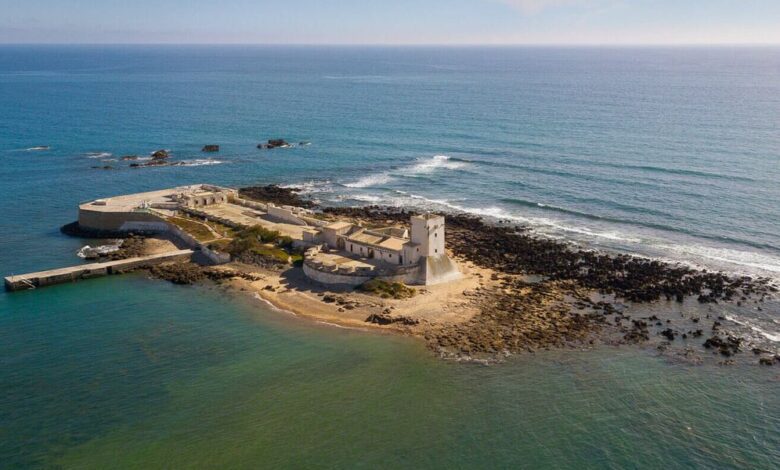
In the south of Spain, where the Atlantic Ocean meets the coast of Cádiz, lies a remarkable place that seems straight out of an adventure novel. A small, rocky islet crowned by an ancient fortress rises above the sea. This is Sancti Petri Island—a unique crossroads of eras, where Greek mythology weaves together with Phoenician beliefs, Roman ambitions, and medieval fortifications. For those seeking more than just a beach holiday on the Costa de la Luz, this destination offers a true immersion in history, wrapped in the salty sea breeze.
From the Sanctuary of Hercules to an Impregnable Fortress
The history of this place stretches back to ancient times. Long before the castle existed, this site was home to one of the most revered sanctuaries in the western world—a temple dedicated to the Phoenician god Melqart, the patron of sailors. Later, the Greeks and Romans identified him with their own hero Heracles (Hercules). Legend has it that it was here the mythical strongman accomplished his tenth labor—the theft of the cattle of the giant Geryon. According to the story, after his victory, Heracles founded the city of Gadir (modern-day Cádiz) and this sanctuary, leaving behind a legacy that has sparked the imagination of historians and travelers for millennia. The temple’s fame was so great that pilgrims from across the Mediterranean came here. It’s said that the great Carthaginian general Hannibal visited the sanctuary to seek the gods’ favor before his famous campaign against Rome. Several centuries later, a young Julius Caesar also made a pilgrimage here. Upon seeing the statue of Alexander the Great, he supposedly sighed bitterly at the thought that, at his age, Alexander had already conquered the world, while he himself had yet to achieve anything remarkable. Biographers believe this moment became a turning point in Caesar’s destiny. Over time, the site’s religious significance faded, giving way to military needs. The current fortress, recognized as a Spanish Site of Cultural Interest, was built to defend the entrance to the Bay of Cádiz. It stands today as an impregnable bastion, rising above the waves between La Barrosa beach in Chiclana and the Punta del Boquerón district of San Fernando.
Treasures hidden underwater
For a long time, the belief that the ruins of a legendary temple lay locked away beneath the waters was just a theory. But in the 18th century, discoveries finally confirmed the ancient texts. Spanish historian Juan Agustín Ceán Bermúdez, in his work on Roman antiquities, pinpointed the sanctuary’s exact location, basing his account on the findings from 1730 and 1748. At that time, foundations of ancient buildings were unearthed from beneath the water and earth, along with “precious statue fragments and other antiquities” that left no doubt about the site’s historical value. But the most spectacular discovery was yet to come. In 1905, an ordinary diver inspecting the seabed near the island stumbled upon something extraordinary: a remarkably well-preserved marble statue of a deified Roman emperor. This artifact, dated to the 2nd century AD, was a sensation and striking proof of the sanctuary’s former wealth and grandeur. Today, this unique find is one of the main exhibits at the Museum of Cádiz—a silent witness to the thousand-year history held by these waters.
Sancti Petri today: how to get there and what to see
Today, the island is no longer just a silent guardian of the past. It has become a vibrant cultural and tourist hub, especially during the summer season. Visitors are treated to fascinating guided tours, including theatrical performances where actors in period costumes reenact historical events, bringing history to life in a way that’s engaging even for children. Open-air concerts are held within the old fortress walls, creating a truly unique atmosphere. There are several ways to reach this historic enclave: small boats depart regularly from the ports of San Fernando and Sancti Petri (Chiclana de la Frontera). For adventure lovers, kayaking is an option—especially popular at sunset, when the fiery sun slowly sinks into the Atlantic, painting the sky and castle in breathtaking colors. This kind of trip promises truly unforgettable impressions and the chance to capture stunning photographs.






